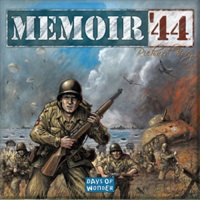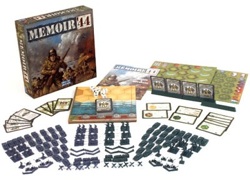
|
About OgreCave and its staff
|

|
by Daron Patton
Memoir '44 has been out for a few years now. It has amassed several expansions (some of which I'll be reviewing beyond this base game review) and has a pretty loyal following in my local game scene and on numerous board game websites. Memoir '44 is a board game of World War II combat, featuring combined arms action. Players take command of Axis and Allied Forces, facing off in historical scenarios designed to convey the general terrain and army compositions that actually fought the original battles. Units have unique combined arms strengths and limitations similar to real world infantry, tanks and artillery. Having been recently re-introduced to Richard Borg's Command & Colors game engine, I used some extra money to go ahead pick up the base Memoir '44 game. I'll state up front that I've never been a WWII buff but have recently gotten into gaming the period in miniatures and other gaming outlets. The base game cost me $50 at the LGS and that seems to be the going rate for the set. The box is well constructed, and works very well to store all the base game's components (something I'm grateful for after playing other games).
Storm the beaches! Which brings up the topic of simulation. Memoir '44 is a historically themed game, but my limited experience, added to input I've had from fellow gamers (in person and on the net) confirm that it's not really a simulation game. I am completely fine with that and actually find the scenarios provided make me want to learn more about the actual battles that inspired the in-game set-ups. What I'm trying to say is, don't expect an in-depth recreation of WWII events down to the last bolt on a Sherman tank. That said, I think even hard core rivet counters will enjoy Memoir '44 because it's WWII and light enough that you can get others who might not be so hardcore into playing the game. Here is the general turn sequence once you've set up and are ready to play:
Command cards can either be section cards or tactics cards. Section cards let you activate a certain number of units in a section (left, center or right). Tactics cards also have combat effects but with a different slant. You might get an air power card, for example, that allows you to call in an air strike on your opponent (the game doesn't really have airplanes other than as a card effect, by the way). With both types of cards in the deck, card/hand management is an important part of playing the game. One thing I've experienced in this game's play, and something that others have commented on as well, is the luck factor. Bet on it that as soon as all of your units have been moved out of the left flank or destroyed so you have no units on your left you will draw nothing but left flank cards. While that can be frustrating, it's also part of the fun. I still think more skilled players, those that know how to manage their forces and their card hands effectively, have a better likelihood of winning.
Obstacles and terrain also affect unit movement. Bunkers, woods, barbed wire, and such all affect how units move or whether units can even enter certain hexes. For example, infantry can enter hexes with hedgehogs while tanks cannot. (Hedgehogs, by the way, are big metal pyramid-looking things designed for hindering tank movement. You may have seen them in Saving Private Ryan.) For shooting/close combat, you have to be able to see (line of sight) the target and be in range. Artillery can potentially hit targets 6 hexes away and usually don't get their dice reduced for terrain benefits. Armor and infantry, on the other hand, can only attack things out to 3 hexes away. Tanks always roll 3 dice for combat while arty and infantry roll progressively fewer dice as their range to the target increases (e.g., at three hexes away infantry only roll a single die but at only one hex away they roll three dice). Again, these general shooting rules also require line of sight to the target and may be affected by terrain. For example, attacking a wooded hex reduces dice for infantry and armor to reflect cover, maneuver, etc. If your armor or infantry unit resolves a fight where you are adjacent (close combat) with the enemy and the targeted unit retreats, you could also claim their hex and even attack again in the case of tanks. You resolve battles by rolling the special d6 dice included with the game. Each die has special symbols as follows: grenade, star, tank, infantry (on two sides) and a flag. When you attack a unit, you roll the amount of dice you are allowed (remember terrain) and hope to roll grenades, infantry or armor. Infantry are damaged by grenades or infantry symbols; Tanks are damaged by grenades or tank symbols; Artillery are damaged by grenade symbols. The star symbol signifies a miss in virtually every situation, while Flags can cause the affected unit to retreat. Units that cannot retreat, either through inability to move through other units or by being forced off the board, are whittled down, one component at a time for each space they would be required to move but cannot. For example, a depleted infantry unit (3 pieces, for instance) on the board edge that is required to retreat three spaces (3 flags were rolled in combat against them) would lose three pieces and be completely wiped out. Here's an example: I have a full unit of tanks (3 tank pieces) in a hex and they're in a section that my command card said I could activate this turn. I want to defeat an opposing infantry unit (4 infantry pieces). Assuming I have line of site and range once I complete my move, it's time to roll dice. Since I am fighting infantry, I want to roll grenades and/or infantry symbols to cause maximum damage. A flag or two would also be nice because I might be able to force that unit off the board or into other units, which will cause it additional casualties. I roll and get two infantry symbols and a star. The star is a miss. For each infantry symbol I rolled, my opponent has to remove an infantry piece from the targeted unit. This shows the unit weakening but does not impact my opponent's infantry movement or firepower. As long as even a single piece remains in a unit, it can move and fire just like it had full strength – it's just weaker at absorbing punishment. Memoir '44 is a scenario driven game. In addition to the ones included in the book, you can download additional new scenarios from Days of Wonder or make up your own. Because you can play the game several times in a single evening, it's kind of neat to play a scenario then set up again and swap sides to see how things turn out. The first 16 pages (and they are large print with nice graphics) are the rules. The remainder of the 35-page book provides 17 scenarios (16 regular and one Overlord scenario, Omaha Beach). Overlord scenarios require players to combine two or three base set boards and components in order to play. These are big scale games that help convey the grand scale of some battles. I haven't played the Overlord scenario yet, but it also requires a free rules download that you can get from the publisher's site. As you work through the scenarios – I recommend going sequentially if you can – you start off slow with infantry-only battles and build up to add tanks, artillery and various obstacles and terrain types in the game. You win scenarios by claiming "medals" earned by capturing objectives per the scenario rules and by eliminating enemy units. Each enemy unit you wipe out gets you a medal toward winning the game. Say the mission has two bridge objectives and requires four medals to be won – I can win by taking both bridges and wiping out two enemy units; wiping out four enemy units; or wiping out three units and taking a bridge.
Conclusions
|
||||
 Memoir '44 (2004)
Memoir '44 (2004) There are three unit types: infantry, armor, and artillery. The little
tanks, soldiers and howitzers that come with the game are bunched by
unit type when you field them. For example, you can't have infantry and
tanks in the same unit. Infantry start the game with four soldiers in a
hex. Tanks come three to a unit and artillery units have two guns. In
terms of movement, artillery is the slowest, then infantry, with tanks
being the fastest.
There are three unit types: infantry, armor, and artillery. The little
tanks, soldiers and howitzers that come with the game are bunched by
unit type when you field them. For example, you can't have infantry and
tanks in the same unit. Infantry start the game with four soldiers in a
hex. Tanks come three to a unit and artillery units have two guns. In
terms of movement, artillery is the slowest, then infantry, with tanks
being the fastest.